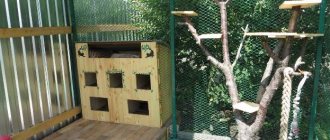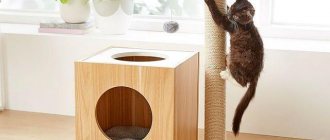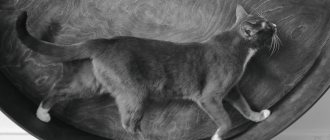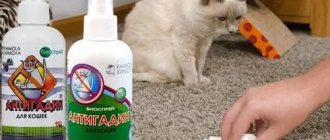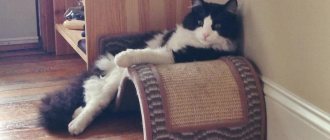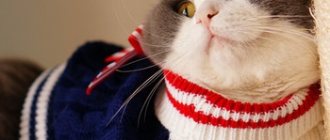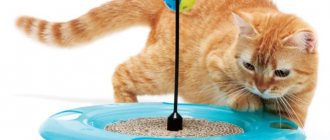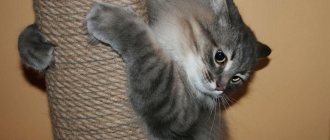Features of living space: secrets of choice
An enclosure is usually called a stationary outdoor structure, equipped with everything necessary for a pet’s long stay.
The first enclosures for meowing pets appeared in North America; there, similar fenced courtyards received a special half-joking name - catio (by analogy with a patio, courtyard). The practical invention quickly spread throughout the world, although in our country it is still not a tradition, but an exotic one. For owners who are thinking about purchasing such a structure, there are recommendations to help them choose the best option. When choosing an enclosure, think about the following things: Placement. The best place is protected on one side by a house wall or fence - it’s more comfortable for the cat. If space allows, the structure is installed on a veranda or terrace.
There is room for owners tooSource houzz.com
- Size. The larger the territory, the calmer and more confident the animal will feel. The fenced area should correspond to the number of pets, especially if you are purchasing an enclosure for kittens and a mother cat.
- Material. Domestic manufacturers offer collapsible structures without a floor on a wooden or metal frame, covered with PVC-coated welded mesh.
- Roof. It not only protects a nimble animal from escaping, but also serves as protection from bad weather and direct sunlight. A flat roof should have a slight slope; the presence of a drain to eliminate puddles on the floor is welcome.
Project with a roofSource ydachadacha.ru
- Design features. The enclosure is equipped with a gate, which is closed with a bolt (latch); Some models provide a feeding window, as well as space for bowls and a tray.
- Facilities. The owners themselves decide what needs to be purchased additionally to ensure the comfort of their pets. Usually this is a cozy house for a cat, a scratching post, transition bridges and multi-level shelves, and a play complex.
Many owners prefer not to buy a ready-made one, but to order an individual enclosure for their animals at the dacha. This is a brilliant opportunity to create ideal living conditions for your pet; An individual approach will take into account many factors:
Set the desired dimensions.
In the backyardSource petaccesssolutions.com
- Design an enclosure for a specific location (for example, on a terrace).
- Select gender. Linoleum, tile, wood flooring or gravel will do. You can sow the lawn or order a combined option.
- Equip the enclosure with a separate passage to the residential building.
- Design a special cabinet in which equipment for games will be stored.
- Equip a vestibule in front of the entrance, if space allows (some cats love to escape).
On the terrace of the houseSource bazovo.ru
Often, enclosures for cats in a private home are built by the owners themselves. The implementation of a seemingly simple task has its pitfalls. The enclosure must cope with the main function assigned to it - to provide the cat with a safe life. Therefore, the correct choice of materials and high-quality assembly of the structure come to the fore. For example, the mesh size should be small enough so that the cat cannot stick out its paw and get stuck. Also, if there is no floor in the enclosure, then the bottom edge of the mesh must be dug into the ground. If you have never been involved in the construction of such structures, execution errors can result in trouble for a furry family member.
About the family of cats in the enclosure in the following video:
The adaptation period - how it can be dangerous
Adaptation of a Maine Coon kitten lasts about two months.
A few simple rules will help your Maine Coon kitten easily adapt to your home. An adult Maine Coon cat is smart, has good health and practically does not cause problems in its maintenance, but a small kitten that will have to grow up and adapt to the conditions of your apartment will need special attention.
The adaptation period for a small Maine Coon will last about two months. Moreover, the very fact of moving the baby to a new home is a huge stress for the kitten. He finds himself in an unfamiliar environment, the friendliness of which he does not yet suspect, being cut off from his mother and already familiar conditions.
Usually, when Maine Coon kittens are transferred to a new family, they are already dewormed and vaccinated (according to the age schedule), but against the backdrop of high stress from the move, immunity failure, “breakdown” of vaccinations and other troubles can occur. To minimize the risk to the health of your Maine Coon kitten, you should follow some simple rules based on forethought.
Variety of models
Stationary designSource pinterest.com
A Grand SolutionSource hatchfest.org
Aviary with a wooden frameSource idei-dekoru.com
With a combined floorSource idei-dekoru.com
Loft styleSource pinterest.com
The aviary can fit into any landscapeSource pinterest.com
Requirements
There are several basic requirements for cat fences.
- The enclosing structure must be functional, and its dimensions must be comparable to the number of furry pets.
- It is advisable to equip any outdoor structure with an awning or a waterproof roof. This will not only protect the cat from the rain, but will also prevent the agile animal from jumping over the walls of the enclosure.
- Another detail necessary for an outdoor enclosure is gutters, otherwise, after rain, water will begin to accumulate on the floor of the structure, which will significantly worsen the pet’s living conditions.
- The design of the floor of the enclosures can be very monotonous. Most often, tiles or linoleum are used; in some cases, plank floors are installed, and some areas are decorated with artificial turf. It is extremely important that there are not too large gaps between the bottom and the side walls, as this could cause the cat to get out and run away.
- When choosing material for walls, you should first of all proceed from the conditions in which you plan to install the enclosure. Street structures, as a rule, are fenced with chain-link mesh, and apartment fixtures are blocked with thick fabric. The use of glass materials is prohibited.
- It is better to place outdoor structures in dimly lit areas protected from drafts. Exposure to direct ultraviolet rays is equally dangerous for both the hairless Sphynx and the long-haired Maine Coon.
- If the enclosure is being set up for indoor use to keep newborn kittens, it is important to create all the conditions for the cat’s unhindered access to children. And at the same time, the freedom of young animals should be limited - here the installation of a window or a special damper is optimal.
- Any enclosure, regardless of size, must be equipped with drinking bowls, a cup for food, and a tray with filler. If the pet is in short-term foster care, then the role of a tray can be played by a disposable diaper.
- To make the animal’s stay as comfortable as possible, it is advisable to equip enclosures with houses and all kinds of play complexes.
- Even being in an enclosure cannot protect an animal from diseases, so such pets, like all others, need timely vaccinations, treatment against helminths, ticks, and fleas.
- As for the Voltaire form, there are no restrictions. This could be a walking trail, a multi-level recreation area, a games room and much more.
DIY construction
The aviary can be purchased ready-made; now there are a lot of offers. But, if you have the desire, time and materials, you can try to construct the enclosure yourself. There is nothing complicated about this, since, in fact, the fence is built for a cat and in this case the strength characteristics are much lower than, for example, for a dog.
Tools and materials
To build an enclosure for a cat you will need:
- metal mesh with medium-sized cells;
- timber having a cross-section of 50*50 cm. The exact size depends only on the area of the building;
- fastening materials (screws or nails);
- rope and pegs for marking;
- hammer or screwdriver;
- building level;
- metal corner;
- door lock;
- roulette;
- roofing material;
- drainage system.
Important! Materials for the enclosure should be chosen as safe as possible, without an unpleasant odor, non-toxic and excluding the possibility of injury to the cat. It is worthwhile to dwell in more detail on the mesh used for the enclosure, since it is the main element of the design
There are several species that are equally suitable for making a cat enclosure
It is worthwhile to dwell in more detail on the mesh used for the enclosure, since it is the main element of the design. There are several types that are equally suitable for making a cat enclosure.
So, chain-link is a budget option that is suitable for building an enclosure, but is not absolutely correct. This happens because the mesh elements are not welded to each other. This allows the cat to get hurt if it climbs on the mesh of the enclosure or sticks its paws into the cells.
Welded mesh is the most suitable material, thanks to which the cat will not be injured. So, if you choose such a mesh with a polymer coating, you can significantly increase the life of the enclosure.
Construction mesh made of stainless steel woven type. This type of mesh is not suitable for enclosures, as it is again dangerous. There is also an all-metal mesh, which is a sheet of metal with holes. In general, it should not be considered as material for an enclosure.
Preparatory work
Before construction, a project for the future structure is always drawn up in order to first carry out the details according to the finished drawing, and then connect them. Typically, a cat enclosure is made in a rectangular shape of the area that is relevant in a particular case. So, each cat should have at least 6 square meters. m.
The site for the construction of an enclosure for cats is also being prepared. It must be cleared of debris, unnecessary plants, bushes, and stumps are uprooted. And also the top layer of soil, which is fertile, must be removed.
Installation algorithm
The installation of an enclosure for cats on the site is carried out using the following technology:
Advice! Several walls of the enclosure can be made solid so that the cats have protection from the wind and a secluded corner.
The most common cat house configurations are similar to dog houses. It is best to place such a house on a low pedestal so that the pet can climb inside. This design will protect the sun, wind and rain, and will also become an excellent place for the animal to rest.
Those craftsmen who have experience in building enclosures for cats, as a rule, offer beginners to familiarize themselves with tips that will allow them to create the right design where cats will be comfortable:
Some tips from the professionals
Those craftsmen who have experience in building enclosures for cats, as a rule, offer beginners to familiarize themselves with tips that will allow them to create the right design where cats will be comfortable:
- The size of the enclosure should be proportionate to the number of pets that will be in it.
- The design of the cat enclosure can be anything that the owner likes and will be comfortable for the pet to live in.
- Materials for the enclosure must be treated with solutions against corrosion and other unpleasant consequences of environmental influences.
- An outdoor structure for cats must have a roof. It is needed not only for protection from bad weather, but also to prevent the cat from jumping over the fence.
- There should be no gaps between the wall and the floor of the enclosure through which a flexible cat can easily slip out.
- The installation of an aviary near the house is carried out in a shaded place. Regardless of the breed, prolonged exposure of a cat to scorching rays can cause health problems for the pet.
- To create comfortable conditions, an enclosure for cats must be equipped with play complexes, houses, drinkers and bowls.
- Regardless of the fact that the animals in the enclosure have limited communication with yard cats, they should be vaccinated and treated for fleas and worms in a timely manner.
- Often a few herbaceous plants or flowers are planted inside the enclosure, which can create shade and act as decoration. But it is worth remembering that there are plants that can harm the health of your pet. These include: hyacinths, ficuses, lilies, irises, hippeastrums, lilies of the valley, evergreen boxwood, jasmine gardenia and ivy. You should refrain from planting these varieties.
https://youtube.com/watch?v=rRB60dC1oB8
How to do it yourself
We will advise you on how to make a fence for a cat in your country house or on the site of a country house with your own hands. First you need to decide on the size and location. The minimum dimensions of such a pen for one cat should be 2x3 meters. We will make the enclosure from metal pipes with a diameter of 1 inch. A fine mesh netting is suitable for walls.
Design requirements
Such an enclosure must comply with all sanitary standards. Even with the smallest dimensions, it must provide space for a toilet tray, a container for food and fresh water. Installing a small house for cats to rest is encouraged. You can equip the interior space with a playground with stairs and multi-tiered shelves, toys tied to them, numerous labyrinths and a place for hiding, and hammocks.
Tools and materials
What materials will be needed when making an aviary:
- metal pipe;
- chain-link mesh, wire to strengthen it;
- wooden beam;
- slate, slate nails;
- self-tapping screws;
- cement, sand, crushed stone.
Tools:
- shovel;
- welding machine;
- drill;
- screwdriver;
- plumb line
Step-by-step instruction
- Mark the dimensions of the enclosure on the selected area, according to the chosen plan, and dig holes around the perimeter at a distance of 1-1.5 meters for installing posts - metal pipes. The length is selected taking into account the roof slope. Provide space for an entrance gate.
- Insert pre-cut posts of a certain length into the holes, strengthen them vertically with crushed stone and concrete.
- We weld the same pipes onto the upper parts of the posts around the perimeter. The roof frame is ready.
- We install the mesh using wire and welding.
- We attach a wooden beam to the upper frame with self-tapping screws.
- All that remains is to lay the slate, securing it securely with slate nails.
- We make a gate separately and hang it on one of the posts using welded hinges, not forgetting about its secure fixation (latch).
- The design of the floor can be different, in our case it is lawn grass. Other options: pea gravel, poured concrete, paving slabs, boardwalks, untreated natural stone walkways.
We made an enclosure using mesh for the walls. We offer another option - to build a similar enclosure next to the country house. Then the wall of the house with the window will simultaneously serve as one of the walls of the enclosure. The animal will have an unhindered opportunity to enter and exit home through the window.
Posting rules
When placing an enclosure in an open space, certain rules should be followed:
- the cage should be located in the shade;
- minimal exposure to wind should be provided;
- locate the structure on a hill to prevent flooding;
- placement preferably in a quiet, secluded corner of the garden.
We hope that our tips will help in caring for your pet.
| Unfortunately, ready-made enclosures for cats are not sold in Russia (if this is not the case, we will be glad to have a link to the store). Only cages of different sizes are available for sale, as well as enclosures for dogs. A cage is not suitable for walking a cat in the summer - sitting in it is torture for a cat, because any cage is still too small. The enclosure for dogs is suitable in size, but, as a rule, such enclosures use a mesh with too large cells - a cat may escape from such an enclosure. You can, of course, buy a dog enclosure and cover it with a more suitable mesh, but it will be quite expensive. Therefore, let’s consider the question of how to make an enclosure for a cat with your own hands. First, we need to purchase materials. Namely:
|
Types of structures
All types of fencing structures are conventionally divided into three types:
- Aviary for a cat. It is a stationary street structure of impressive size. Usually it is installed on a private plot, less often on a veranda in a house or balcony. It is equipped with everything necessary for a pet's long stay.
- Cat cage. A small portable or stationary container. Made from wooden or metal rods. Serves for short-term keeping of a pet in an apartment or outdoors.
- Playpen for a cat. The design is represented by a portable container, usually of a folding type. The material used for manufacturing varies. Fabric products are more convenient; metal or wooden analogues are less often chosen. Comment! Such a device is more suitable for keeping kittens in an apartment or house; an adult can easily overcome an obstacle without a roof.
Functions
Many people believe that a pet enclosure is more of a fad. This is wrong. All cats are predators by nature; they need time to play and warm up their muscles, which is why an enclosure is considered the optimal solution.
The tradition of creating enclosures for cats and cats came to us directly from North America. There, for the first time, such structures appeared in nurseries with the largest breeds. Quite large structures located over large areas in private homes are called “catios”. This term was formed from two words: patio - “yard” and cat - “cat”. The idea appealed to many owners of these pets, and enclosures began to be installed in ordinary homes, as well as in country houses.
The aviary is a very functional design. In the summer, many city residents move to their dachas and country cottages, naturally taking their pets with them. As a rule, no difficulties arise during the move, but upon arrival, quite serious problems begin. Firstly, an animal accustomed to living in a certain (most often closed) territory can simply wander off and get lost. Secondly, in nature he encounters neighbors’ cats
Such a meeting threatens special troubles for cats, whom many village cats strive to surround with their attention. The consequences of such acquaintance are often unwanted pregnancy, fleas, lichen and intestinal parasites
Another fairly significant danger to animals is posed by stray dogs, as well as the cars of summer residents.
That is why a good solution would be to arrange the cat’s area so that the pet is protected from external threats, but does not experience discomfort.
In addition to outdoor structures, there are enclosures installed in interior spaces. The reasons for such obstacles can be very different:
- giving birth to a cat;
- the need to protect a purebred cat from a cat;
- period of the animal's overnight stay;
- protecting the animal from small children;
- period of temporary foster care for the pet.
Dog Door Ideas
The so-called dog or cat door (damper) is a good idea for a dacha, especially if the area is securely fenced and “strangers” will not enter the yard (and therefore the house). You can cut a small entrance in a street door yourself, but the “store” option will be much more aesthetically pleasing and functional. Nowadays there is a large selection of dog doors with various mechanisms that allow you to keep the room warm and limit the entry and exit of your pet.
The door for the animal can also be an interior door, which solves, for example, the problem when the tray is in the bathroom, because it is impossible to constantly keep the door to this room open.
Your efforts will be rewarded, because the care shown will be returned with the love and devotion of your four-legged friend.
We invite you to familiarize yourself with: Evening primrose Missourian golden
The so-called dog or cat door (damper) is a good idea for a dacha, especially if the area is securely fenced and “strangers” will not enter the yard (and therefore the house). You can cut a small entrance in a street door yourself, but the “store” option will be much more aesthetically pleasing and functional. Nowadays there is a large selection of dog doors with various mechanisms that allow you to keep the room warm and limit the entry and exit of your pet.
Construction of an outdoor enclosure
The difficulty of making a cat enclosure with your own hands depends on the size of the structure and the installation location. Like any construction, the design of an enclosure begins with design. The dimensions of the structure are determined taking into account the breed and number of cats. Keeping a Mei Coon in a fence requires more free space compared to other breeds. The minimum area is considered to be 2x3 m per pet.
Advice! If the cat's enclosure is intended for long-term use, it is better to take care of designing a simple foundation.
The main stages of arranging an outdoor enclosure:
They are engaged in marking the territory in accordance with the plan. Pouring the foundation. After the concrete gains strength, they proceed to forming the walls of the enclosure. First, the support pillars are installed. It is optimal to use metal pipes; concrete pillars are less commonly used. Moving on to arranging the roof. If the enclosure is located in an open space, it is advisable to make a waterproof roof. Slate or metal tiles are more practical than polycarbonate, which allows the rays of the sun to pass through. Installing an enclosure for cats in the shade of trees and the presence of houses allows you to get by with a net. When choosing a mesh for the walls of the enclosure, pay attention to the size of the cells
It is important to prevent the cat’s paw from getting stuck in them. The design of the floor is chosen at the discretion of the owner. Possible options are gravel, concrete, boardwalk, lawn grass, a combination.
How to make an Aviary for cats: for / apartment and home, we make it with our own hands. Today, our beloved pets have become full members of the family, caring for which sometimes overwhelms us and forces us to devote more strength, attention and money to them than to ourselves.
For this reason, more and more pet owners have begun to make adaptations that make their pets comfortable.
In this article we will pay attention to such interesting designs as enclosures for cats. By nature, our favorite furballs, namely cats, are predators
They need a lot of space to train and play. In this case, a cat enclosure is the optimal solution. Quite often, when constructing such structures, a separate place is allocated for the playing area. Loving cat owners create entire playgrounds and even towns, without spending money on expensive materials, but using only boxes
By nature, our favorite furballs, namely cats, are predators. They need a lot of space to train and play. In this case, a cat enclosure is the optimal solution. Quite often, when constructing such structures, a separate place is allocated for the playing area. Loving cat owners create entire playgrounds and even towns, without spending money on expensive materials, but using only boxes.
Most people are accustomed to taking their animals to their dacha, where they move for the summer. And even if no problems arise during transportation, they may begin after arrival. Usually the problem appears in the form of neighborhood cats who ardently want to meet your kitty. After meeting the village folk, your pet may be rewarded with fleas and even unplanned offspring.
Another danger for pets is stray dogs and cars. According to statistics, animals that live primarily on the street live much shorter lives. This same chance is halved given the fact that your domesticated animal is unlikely to know what to do if attacked and what damage vehicles can cause.
Reasons for purchasing a cell
There are many more reasons to buy a cat cage than might seem at first glance:
- going to the vet;
- trip to the country;
- relocation or flight;
- cat pregnancy;
- pet washing;
- postoperative period;
- exhibition;
- keeping in a shelter;
- catching an animal;
- disciplining the beast.
Whatever the reason for placing your pet in a confined space, it is important to remember that the cage does not limit the freedom of the pet, but ensures the safety of the predator and makes it easier to care for.
How to make a home aviary?
A metal cage made of mesh is the most practical, simple and cheap. Therefore, first of all, we will tell you how to make it yourself. To make a home shelter for a pet, you need:
- choose the shape of the structure and assemble the appropriate frame from metal rods;
- stretch the prepared mesh over the frame, twisting the structure with pre-cut pieces of wire;
- one of the parts of the mesh must be placed on hinges - we will get a door that will be tied to the walls with a cord;
- We additionally cover the floor inside the arena with linoleum, place a sun lounger in the place where the dog will rest, and place a fabric bedding;
- We put containers for food and water, pet things, and create comfort.
An apartment enclosure for small and medium-sized dogs can be built from wood. Some find it more familiar and convenient to work with such material; slats and boards are easier to obtain, so this option is preferable. The playpen is performed in the following sequence.
- Determine the size of the required enclosure according to the breed of the dog.
- The slats are measured and cut to the required length to make the frame.
- The frame parts are connected using corners and self-tapping screws.
- Determine the height of the arena. We cut thin boards to the required length and attach them to the frame at a short distance from each other, like a fence. This is how we get the walls of the enclosure.
- We make a rectangular frame of the door from slats, and nail boards to it according to the pattern of the walls.
- We fix the gate to the awnings and attach a latch for closing.
- We cover the floor and equip the interior of the structure. The playpen for puppies or for an adult dog is ready.
You can make an apartment cage with a closed top in the form of a cage as follows.
- Prepare a frame in the form of a cube from wooden beams, fastening them with self-tapping screws (height 75 cm, width and length 1 m).
- In the middle of the front wall, make a vertical crossbar from timber, onto which the door hinges will be fixed.
- We will make the walls from masonry mesh with 50x50 cells, with a rod thickness of 2-3 mm. It is available for sale in construction stores. We cut the mesh into squares 100 cm x 100 cm - 1 pc. (for the ceiling), 75 cm x 100 cm – 3 pcs., 75 cm x 50 cm – 2 pcs.
- We attach the mesh to the frame using two self-tapping screws with a press washer.
- We hang the door on its hinges and attach the latch to close it.
- Check and cut off any sharp elements of the mesh so that they do not injure the animal.
- Cut the floor from chipboard or plywood and attach it to the frame.
The enclosure that will be located at your home can be made from chipboard. This design is perfect for puppies and small apartment dogs. The advantages of the structure are its strength and at the same time the low price of the material. Such an enclosure is easy to assemble and can be used for a long time.
To make a square enclosure, the material is cut into rectangles of the required length and height. Chipboard slabs are fixed at the corners using timber inside, and fixed at the top with corners. A door is made in one of the walls at some distance from the corner. It is fixed with 2-3 loops. A latch is installed on the inside of the gate.
To make a plastic aviary-playpen, you need:
- cut the profile pipe into pieces, the length of which will correspond to the height of the enclosure, and into pieces 5 cm long to connect the lattice;
- we connect a long tube with small tee fittings, getting a fence, we fix the assembled walls with plastic corners;
- We make the distance between the rods smaller so that the dog does not jump out and get stuck between them.
The disadvantage of this design is the difficulty in hanging the door. And putting a pet or puppy through a fence every time is not very convenient.
Main varieties
All types of animal fences are divided into three main types:
Cell
The three-story Cat Playpens cage, with dimensions of 91.4 * 58.5 * 127 cm, will appeal to any pet or several cats at once, since there is enough space here. There will be drinking bowls and feeders, trays, as well as numerous equipment for animals. The cage is metal, black, with two doors. If necessary, animals can be isolated from each other. Has the following advantages:
Manege
The Triol model represents an octagonal-shaped enclosure-tent for pets. The playpen is made of synthetic environmentally friendly material (100% polyester) and has dimensions of 740*740*345 mm. Under the fabric there is a rigid metal frame, the structure is foldable. When assembled, the playpen does not take up much space. If necessary, a removable roof made of rubberized fine mesh is placed on top, which closes with a zipper. All 8 large windows around the perimeter are equipped with the same mesh. The waterproof bottom is removable and can be easily and quickly secured with adhesive tape.
The playpen is perfect for a cat before giving birth and for keeping a kitten with her. Can be used both at home and in the garden.
Manufactured in three sizes. The price, depending on the size, ranges from 2,900 to 4,470 rubles.
Aviary
Galvanized enclosure for kittens (Dog Land). Reliable coating will last for a long time. Sold in sections, which can be easily assembled into any desired shape on a summer cottage or on the site of a country house. The size of one section is 60*55 cm. The segments are fastened together with plastic ties. The price of five sections will be 1,200 rubles.
The enclosure is suitable for keeping cats and dogs in open areas.
The enclosure can also be used for kittens.
Beds for dogs and cats
For a pet to feel comfortable, it must have its own corner in the house where it can sleep sweetly and feel safe. It’s not difficult to make a sunbed: just take a container of the right size and cover it with a towel, adding unnecessary rags. A cardboard box, chest of drawers, suitcase, etc. will do.
You can make a whole house for a cat. See how unwanted clothes can be turned into a great tent for your pet.
Houses are made from tires and cardboard, and if you are a fan of handicrafts, it will not be difficult for you to knit a warm, cozy house for your pet.
Your pet will certainly appreciate the hammock, which is very convenient to nap or hide in, because the easiest way to make such a hammock is under a chair or stool, attaching the edges to the legs.
Video “Constructing a house”
How to make a house for your pet? It's not very difficult if you put in a little effort. The video will talk about the process of creating a house from simple boxes.
Sorry, there are no surveys available at this time.
Was this article helpful?
Thank you for your opinion!
The article was useful. Please share the information with your friends.
Yes
No
X
Please write what is wrong and leave recommendations on the article
Cancel reply
Rate the benefit of the article: Rate the author ( 2 votes, average: 4.50 out of 5)
Discuss the article:
Recommendations for location and application
This is the cage of your dreams! Now we just have to figure out where to put this structure. Agree, a do-it-yourself enclosure will not always fit harmoniously into the apartment and interior. However, there are several ways to disguise it.
- To keep the dog's enclosure from being conspicuous, you can design it as a small table or cabinet. To do this, a custom-made countertop to match the interior is placed on the roof. However, this option is only suitable for enclosures with a closed top. But in general it is not recommended to close the enclosure. Therefore, it is better to come up with another way to fit it into the interior.
- It’s good if there is a corner in the apartment where the aviary will fit without problems, will not interfere and will not spoil the appearance of the room.
- Mesh enclosures without a roof can no longer be hidden so easily. But, if you manage to make it foldable, the easiest way is to remove it when not needed.
Where should the enclosure be located so that the dog feels comfortable in it?
- Choose a place where your dog can see most of the apartment.
- Avoid sunny places and drafts. The best option for placing the enclosure is one of the shaded corners of a large room.
- Under no circumstances place the cage near a battery or household appliance.
- The enclosure must be designed in such a way that it can be easily disassembled and transported or removed altogether.
And finally, it’s worth dwelling a little on the rules for using and training a dog in an enclosure. It is possible that the animal will not perceive it as something familiar the first time, so you cannot simply lock the dog in a cage.
- Start by letting the finished enclosure just sit in the room with the door open for some time. The dog must understand that he will not harm her.
- After some time, put your favorite toy or animal treat inside. It may not be right away, but the dog will still go inside for an attractive object. Be sure to praise her.
- After some time, involve the enclosure in games, that is, forcing the dog to bring a toy, periodically throw it into the cage.
- Next, training moves to a more complex level - the dog is taken into a crate and, praising it and treating it with treats, is kept in it. When the animal sits quietly in an open structure for more than 5 minutes, close the door briefly. When the dog is released again, it must be praised and treated.
cat tree
During the summer season, many cats love to climb trees: it is healthy, fun and interesting. But with the onset of cold weather, such entertainment ceases to be available, which is why pets accustomed to an active lifestyle can begin to damage furniture with their claws and climb onto shelves and curtain rods, tearing off curtains and turning everything upside down.
There is a way out - a tree for cats, which you can easily make with your own hands. Here are some ideas for a functional and beautiful cat tree.
Manufacturing
You can make an enclosure for cats at home with your own hands. Like any other building, work begins with drawing up a project. Typically, the dimensions of the installation are selected taking into account the number of animals, breed, size of the allocated area and the habits of the pet. For example, keeping a Maine Coon indoors will require much more space than keeping cats of any other breed, and a neutered cat is less active than an untreated cat - he doesn't need a large play area. But still, the recommended minimum area for each pet is 2x3 m - it is better to adhere to it.
Creating an outdoor enclosure involves several key steps.
- Marking the area for the enclosure in strict accordance with the drawings.
- Pouring the foundation.
- As the concrete gains the necessary strength, you can begin building the walls of the enclosure. First of all, the supports are installed. As a rule, metal pipes are used for this; concrete pillars are less commonly installed.
- Next you need to do the roofing. If the structure is located on the street, then the roof is made of slate or metal tiles. They are considered a more practical option than polycarbonate, which allows sunlight to pass through.
- The walls are made of chain-link mesh, and the size of the cells is selected in such a way that a cat’s paw cannot get stuck in them.
- After this, the floor is decorated. The most popular materials are boards, gravel, and lawn grass. It is possible to combine several materials.
- At the final stage, they begin to arrange the interior arrangement of the cat house. It is advisable to cover part of the wall with canvas to protect the animal from drafts. Don't forget to install nesting houses, as well as scratching posts and play structures.
